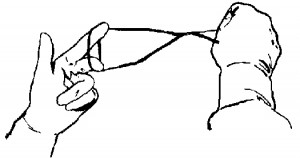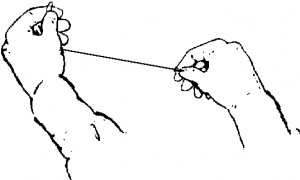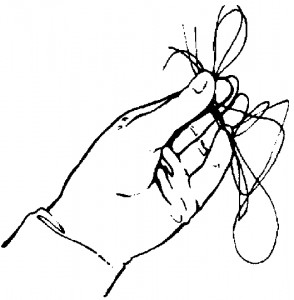a. Just as the physician’s preference card is checked for the instruments he requires for the surgical procedure, the surgeon’s preference card is checked by the scrub and circulator for the right kind of sutures for the procedure.
A suture is a strand of material used to tie blood vessels and to sew tissues together. As a verb, to suture is the act of sewing or bringing together. A variety of sizes, strengths, and materials are used in surgical procedures. Sutures come in sterilized prepacked foil or plastic packets. Surgical gut, nylon, silk, stainless steel, and cotton are just a few examples of the material used in suture. The more zeros in the number, the smaller the size of the strand of suture. The surgeon’s preference card will tell you the type and size suture you will need for the procedure.
b. You should prepare the sutures in the order in which the surgeon will use them. The circulator will pass the suture packets to the sterile area either by flipping them into the basin on the back table or by opening the outer wrapper with the scrub reaching for it with gloved hand or sterile instrument. Suture material without an attached needle is referred to as a “tie.” The scrub will open individual packets of ties using the following procedures.
(1) Tear foil or plastic packets across the dotted line of the packet.
(2) Remove the suture material from the packet, unwind or unfold the material, cut the strand for the proper length, and place these strands under the rolled end of the towel on the Mayo tray. As you work in preparing the ties, you must work over the sterile field to avoid contaminating the tie. Avoid letting the suture ends drop over the edge of the instrument table. Figures 3-26 through 3-29 illustrate the handling and preparation of suture materials.




c. General rules on handling suture material include the following:
(1) Limit handling to the absolute minimum.
(2) Never stretch, jerk, or “test” the strengths of the suture.
(3) Avoid crushing strands in instruments.
(4) Do not run gloved hands over suture to straighten kinks.
(5) Do not open and prepare too many sutures in advance
d. After you have placed all the required ties under the rolled towel on the Mayo tray, unroll the end of the towel and place under the tray. The ties are always removed from the Mayo tray toward the sterile field, never away from the sterile field.
